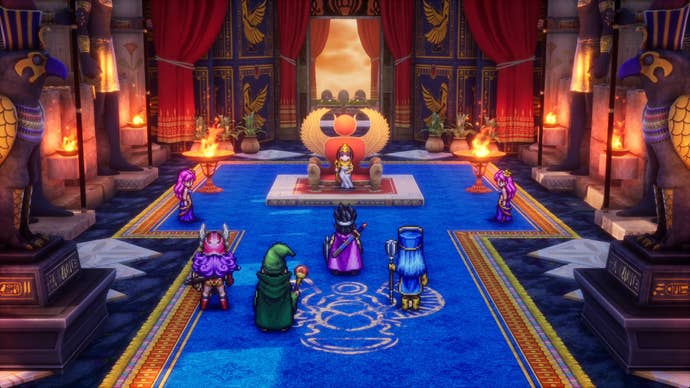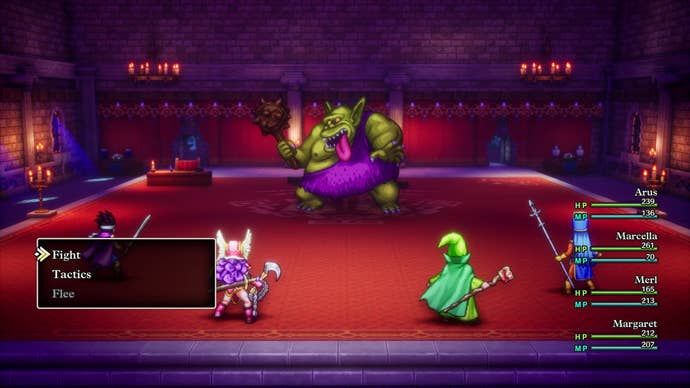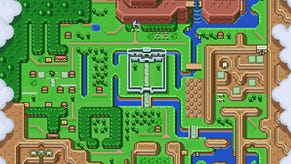Dragon Quest 3 HD-2D Remake is looking like a beautiful, faithful, and powerful history lesson - hands-on
As the Dragon Quest series approaches its 40th anniversary, Square Enix returns to the beginning with what's looking like a gorgeous and incredibly faithful remake.
While in the western world we pay more attention to Final Fantasy, Dragon Quest remains one of Japan’s most important video gaming exports. The truth is, we probably wouldn’t have many of today’s modern Japanese-made RPG tropes without Dragon Quest; it is the game that defined the parameters of the genre as we know it today.
That makes Dragon Quest 3 HD-2D Remake a particularly important title. Arguably, the first three Dragon Quests are a trio of the most important games of their kind; of that three, the third entry is actually the narrative first entry, a prequel to its forebears. This is the ideal Dragon Quest entry point - and any remake serves a purpose not just as a fun video game, but as a wonderful slice of history the better part of forty years in the making.
It’s difficult to get a read on exactly how good the full version of something like an RPG will be based on a demo less than an hour in length, of course. But from what I’ve seen so far, Dragon Quest 3’s HD mulligan appears to be the pitch-perfect offering for that stated mission. It wants to retain everything that makes the original great, but modernized. It wants to provide a new-but-retro entry point to the Dragon Quest series. It seems like it’ll do that.
What’s interesting about this remake is that the Dragon Quest games are staunchly traditional - the early ones especially so. This means keeping them the same but modernizing them has small, but curious, consequences.
Take the addition of a mini map, for instance. This is a big world by the standards of the Famicom, aka the Nintendo Entertainment System, but even compared to the worlds tossed out a generation later by Final Fantasy, it’s actually pretty small and limited. With a mini map that constantly points you to your next main story destination, some of the natural flow of original DQ3 is arrested - you won’t spend hours lost, grinding in random encounters as a result. That element of friction from the original has been removed - which is how experienced players with memory have been playing DQ3 forever, anyway.
This will cause small ripples, though. Some NPCs that have clearly been placed in little homes in fairly random-feeling areas of the world map now feel even more random, because their purpose back in the day was to deliver some line of dialogue that nudges the player back in the right direction.
Those NPCs speak to the very nature of these games - very innocent and simple. By modern standards, they are contrived. Where games made even a few years later would begin to flesh out a story for an NPC who hands over a key item, for instance, bequeathing reasoning and motivation, these early games feel no need for it. “Take this, Great Hero!” they’ll waffle, handing over something valuable without a second thought just ‘cos. It’s part of the charm. In the modern context, it’ll make this game stand out. In the original, the plain talking also made these games some of the best for foriegners to play to practice Japanese - I hope the final release includes all language options in every region.

What’ll also help this remake to stand aside is the art style of the game. Developers Artdink has history with this art style having worked on Triangle Strategy, while co-developer Team Asano pioneered the art style with Octopath Traveler and Live A Live. It’s used to great effect not just to beautify the game, but also to add additional flavor to it.
Back on the NES, all the areas of Dragon Quest 3’s world looked relatively similar - but in the HD-2D remake, the range of color and visual fidelity is used to give every single zone a more unique look. This is a journey right across the world, and the visuals now match that, with the look of each new continent, country, or town drawing visible inspiration from real-world locations in its lovely new pixel art.
The visuals allow for a tiny bit of cinematic flair, too. This stuff is few and far between, but at one point the camera pans down as a character mentions a town that is my destination - giving me a completely different perspective where I can see my destination’s pixels looming off in the distance. It looks great.

The rest of the remake is what you’d expect, including gorgeous new soundtrack arrangements from the Tokyo Metropolitan Symphony Orchestra, new secrets and challenges scattered throughout the adventure, and a little bit of voice-over here and there (though not all dialogue is voiced). The UI has been redesigned, and of course there’s much more detail in animation as well as static visuals.
It all looks and feels pretty good - and like I say, feels like a faithful, smart remake of a very important game indeed. After the loss of two of Dragon Quest’s three creatives over recent years, it feels appropriate for Square Enix and the remaining creator, Yuji Horii, to revisit where it all started. Thankfully, they’re doing so with smarts and respect.
Dragon Quest 3 HD-2D Remake is coming to Nintendo Switch on November 14th. It’ll also arrive on Xbox, PlayStation, and PC on the same day. It’ll be followed by remakes of Dragon Quest 1 & 2, completing the initial trilogy, in 2025.



